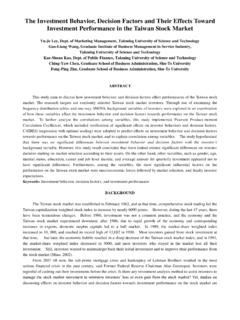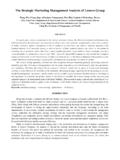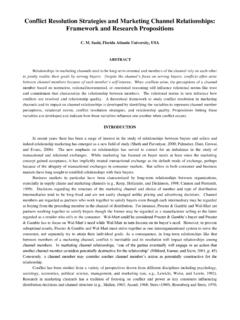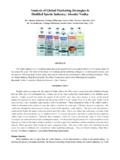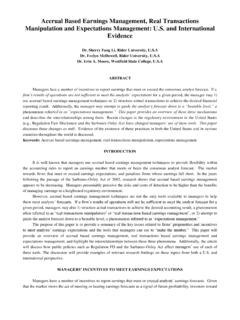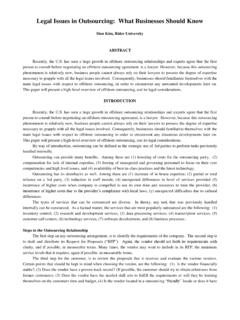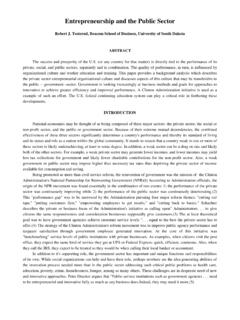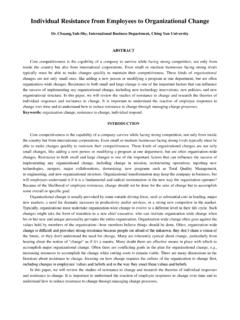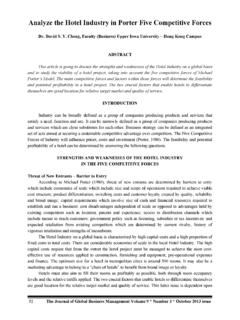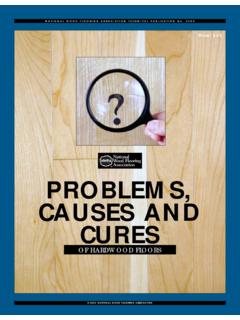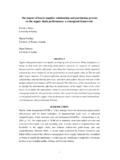Transcription of The Market Share Effect: New Insights from
1 The Market Share effect : New Insights from Canadian Data Peter Yannopoulos, Faculty of Business, Brock University, Canada ABSTRACT This paper examines the relationship between Market Share and profitability in light of evidence that Market Share and profitability may not be related directly but any observed relationship may be the result of a spurious correlation. It also tests the hypothesized U-shaped relationship proposed by Porter, and Sheth and Sisodia among others. The results obtained here do not support the positive Market Share profitability hypothesis. Also, we found no support for the U-shaped relationship. Evidence, however, is found in favor of a positive relationship between profitability and quality of management, especially when the five year average of return on equity is used as an independent variable.
2 The use of the five-year averageas an independent variable also elimitates thepossibility that environmrntal conditions may be responsible for the results. Keywords: Market Share ; Market Share effect ; Profitability, PIMS INTRODUCTION The relationship between Market Share and profitability continues to be an important research issue in strategic management. Rumelt and Wensley (1980) argue that the observed association between Market Share and profitability is an empirical regularity that requires a theoretical explanation. There is a widely held belief that Market Share and profitability are strongly related (Buzzell and Gale 1987; Simon 2010). Research conducted in the 70s by Gale (1972), Shepherd (1972) and Buzzell, Gale and Sultan (1975) supported the hypothesis of a positive relationship between Market Share and profitability.
3 Buzzell (2004) notes that the majority of studies on the topic find a linear positive relationship between Market Share and financial performance. However, there appears no consensus in terms of the findings. Some of the early studies supported the view that there is lack or a negative relationship between size and profitability. But following the empirical and theoretical studies of Baumol (1959), Stekler (1963), Shepherd (1972), Gale (1972) and Buzzell, Gale and Sultan (1975) in conjunction with the increased popularity of the experience curve, a positive link between Market Share and profitability became the accepted view among management and marketing theorists. As a result, consultants and strategy experts advised managers that unless their firm can achieve a high Market Share and/or dominate its chosen Market , the firm should withdraw from that Market and invest elsewhere.
4 More recent research claims that the evidence in favor of the Market Share effect hypothesis is far from being conclusive ( Jacobson and Aaker 1985). Other strategy experts including Porter (1980) and Sheth and Sisodia (2002) advocate a U-shaped relationship between Market Share and profitability. The inconsistent findings and different explanations suggest that there is a need for more research in this important area. The primary objective of this article is to review the literature in this area and present within an organized framework the issues pertaining to the issue of Market Share and profitability. It will also empirically investigate the Market Share profitability relationship using Canadian data.
5 This relationship is tested using a data set that consists of Market and financial data compiled from various Canadian sources. The ultimate objective of this article is to help obtain a better understanding of the Market Share effect . An improved understanding of the central tendency of the Market Share effect can enhance our understanding of the direction and magnitude of the impact of Market Share on profitability. Finding the true nature of the relationship would be of interest to strategic management theorists and practitioners due to the importance of such a relationship. This knowledge can help managers improve the performance of their firms by putting their scarce resources to their most productive use.
6 LITERATURE REVIEW The first attempts to establish a relationship between Market Share and profitability, according to Scherer (1980), were made by industrial organization economists. The most comprehensive early attempts were studies conducted by Epstein (1934), Crum (1939), and Alexander (1949): all of these studies found a negative relationship between profitability and size. In a subsequent study, Stekler (1963) found that profit ratios declined with size for profitable firms, but profits increased with size for small and medium firms when all firms were included. Hall and Weiss (1967) found a positive relationship while Mancke (1974) and Whittington (1980) found no relationship between size and profitability.
7 These first efforts used absolute size whereas most of the later efforts have been using Market Share or relative Market Share as the independent variable and as a measure of competitive strength. Among studies that used Market Share , Gale (1972) found a positive relationship between Market Share and profitability. This relationship was significantly greater when the industry was highly concentrated or industry growth was medium but no significant effect in cases of rapid industry growth. Shepherd (1972) also found a significant positive relationship between Market Share and profitability. In a much discussed study using the PIMS database Buzzell, Gale and Sultan (1975) found a positive link between Market Share and profitability.
8 This article showed that, regardless of whether Market Share is defined by rank or percentage, there is a strong correlation between Market Share and profit margin. The PIMS data set revealed that a company with a Market Share of 40 percent will achieve a profit margin twice as high as the competitor 10 percent of the Market (Simon 2010). Therefore, the strategic implication of these findings is that firms should strive to achieve a higher Market Share in order to reap the advantages of higher economies of scale and experience. Underlying the concepts of economies and economies of scale is that a company s cost position depends on its relative Market Share . The higher the relative Market Share the lower the company s unit costs are and the higher the profit margins.
9 The most important question about the relationship is whether it represents a mere correlation or a true causal relationship (Ailawadi, Farris and Parry 1999). The existence of a positive link between Market Share and profitability was not found in other studies, however. Whittington (1980) tested the relationship between size and profitability and found no relationship between the two variables. In another study, Schmalensee (1985) found a statistically significant but negligible quantitative Market Share effect . Mueller (1986) also found a positive link between Market hare and profitability using longitudinal data, but this relationship was weakened by the existence of concentration levels. Jacobson and Aaker (1985) tested for the existence of a Market Share effect using the PIMS data base.
10 Jacobson and Aaker (1985) found a positive relationship between Market Share and profitability but this relationship disappeared or became negligible when lagged profit variables were included in the model. According to Jacobson and Aaker (1985), although a direct relationship between Market Share and profitability may exist, it may be a spurious relationship and an indirect result of other variables such as quality of management which primarily determines profitability. Buzzell (1990) criticized Jacobson s approach of using one-year and two-year lagged return on investment as inappropriate. Hildebrandt and Buzzell (1991) used a structural equation model to analyze changes in profitability over 6-year periods, a time span more suitable for observing strategic changes in Market position.
